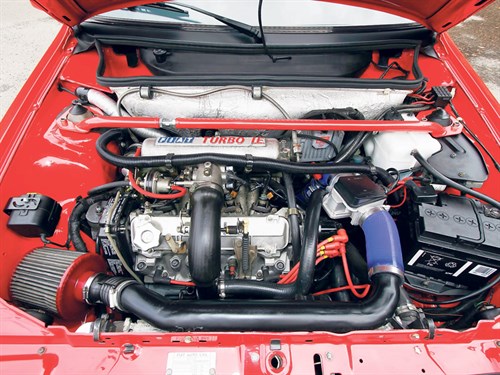fiaThe Fiat Uno Turbo is potent, fun and ever so fragile...

Like many cars of its ilk, the Fiat Uno Turbo relied on forced induction to achieve its Golf GTI-rivalling performance, but the sophistication of its IHI turbo/Magnetti Marelli engine management installation set it apart from earlier rivals. Launched in 1985, it was also state-of-the-art in terms of its packaging – its Giugiaro-styled body had a drag co-efficient of 0.34, and its interior was the roomiest in its class. And thanks to big boost and 105bhp from 1.3 litres, it remains a great deal of fun to drive to this day.
VITAL STATISTICS
1985 Fiat Uno Turbo ie
Engine 1301cc/4-cyl/SOHC
Power (bhp@rpm) 105bhp@5750rpm
Torque (lb ft@rpm) 108lb ft@3200rpm
Top speed 122mph
0-60mph 8.3sec
Consumption 30mpg
Gearbox 5-speed manual
WHAT TO LOOK FOR
BODYWORK & CHASSIS
Fiat has a horrendous reputation for corrosion, which is unjustified once we’re into the 1980s. Thanks to careful design engineering, the Uno is far less rust-prone than the car it replaced, the 127. That’s not to say it isn’t immune – rust can spring up anywhere underneath, so make sure you get it on a ramp for a close inspection. First port of call should be the floor seams – if these are lifting, the floor panels will need replacing. Also check the sills, lifting any plastic skirts for a good look.
Next, check around the fuel tank mounts, boot floor and spare wheel well. A full seam inspection is needed from below – they could be well undersealed, so do take extra care, and look for distorted or splitting seams. Other weak areas are the rear turret top mounts. While underneath, poke around the front inner wings and Macpherson strut turrets and suspension arms, which are all common corrosion areas. And there’s also the engine subframe, which is an absolute pain to weld in situ.
The body is more resilient. The windscreen scuttle and surround is a known weak spot, and tough to repair without removing the windscreen, while the doors and tailgates can rot quickly, especially if their drain holes are blocked. Finally, the sunroof surround and mechanism are rot-prone and difficult to fix.
ENGINE
The Uno Turbo needs an understanding owner who likes to change the oil regularly, preferably every 3000 miles. Fiat SOHC engines are tough, but the turbo places strains, which regular doses of semi-synthetic go a long way to alleviating. Engine life is around 120,000 miles.
Turbos need a close look, so check for white smoke when cold and blue smoke when hot. Check the turbo boosts as it should without too much bearing and wastegate noise. Early cars with an IHI turbo are more costly to rebuild than later Garrett-equipped cars (£400 vs £300). Also check all oil pipes feeding the turbo, and that all breathers and vacuum pipes are in good order. The front-mounted intercooler is also vulnerable to damage.
The fuelling system has been known to cause problems, especially with its injectors – and because of high under-bonnet heat levels, the fuel rail can corrode and become porous. The fuel pump needs to be in tip-top condition, and is located near the tank underneath the car – check it’s delivering as it should. Many owners have fitted secondary pumps.
Finally, ask when the cambelt was last changed, and how regularly it’s been done. These engines might be tough, but they demand OEM high-quality belts and need them changing every 30,000 miles.

RUNNING GEAR
Owners love to lower their Uno Turbos. However, if you’re looking at a lowered car, make sure it’s by no more than 30mm and has good quality springs and – more importantly – dampers (by Pi or Spax) fitted. Suspension is by Macpherson struts all round and most issues affecting handling precision are down to old bushes. Luckily there are plenty of uprated items to choose from, although popular polypropylene items can lead to a harsh ride. Strut braces sharpen the handling and improve steering precision.
INTERIOR
The main problem with Fiat interiors of this period is cheap materials. This, combined with the potential of water ingress from a leaking sunroof, can spell trouble. The first thing to look for is a sagging roofliner – the material lifts from the backing and is a pain to repair. Also, the seat and door trim materials wear (especially on the earlier car) and replacements are hard to find.
The plastic used on the dashboard is brittle, so make sure it’s all together; it will be difficult to find small trim pieces. Finally, check that all switchgear is operating, and that all warning lights and instruments work as they should. Although the wiring is of acceptable quality, bad earths are a real issue and will cause all manner of random problems. Don’t necessarily conclude that a non-working electric window is a broken motor, or that an ineffectual fan blower is a big fix – they could be down to dirty and corroded earthing points.

OUR VERDICT
With a 0-60mph of less than seven seconds and a top speed of more than 120mph, Fiat Uno Turbos still feel fast today. But the kart-style steering and surprisingly capable suspension mean it’s not just the speed that captures your attention. Of course, there are some downsides – supply of cars and parts are far from plentiful, and you’ll need to keep it garaged and tend it regularly. However, Turbo values are still quite reasonable. Best advice is to buy with care and go for an unmodified or lightly upgraded car.